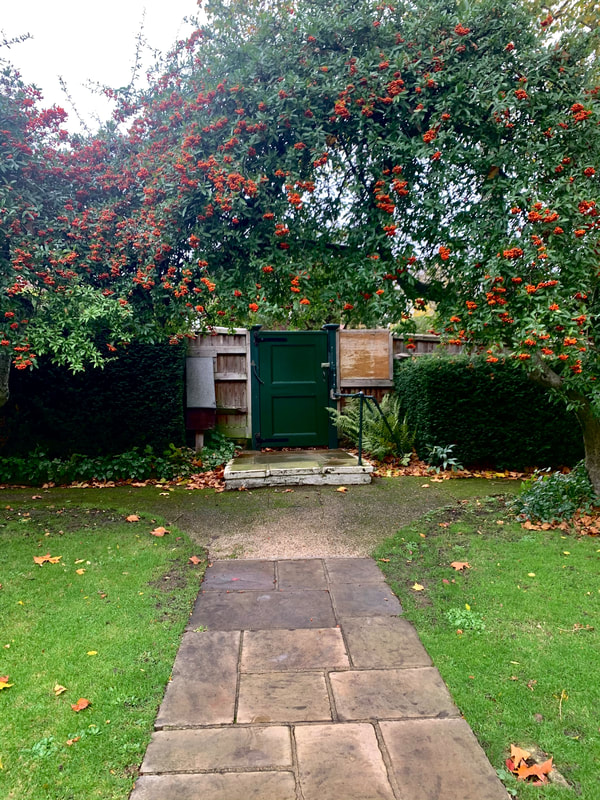|
On November 1, 2020, only a few days before England’s second official lockdown began, I visited Keats House – the quaint, cozy abode in an upscale residential area of London where John Keats lived during a highly developmental stage of his writing and poetry career. It seems wrong to write this now, so many months since my visit and with the light at the end the tunnel for the worst of the COVID-19 pandemic, at least in the developed world. But at the same time, this is the best and only time that I can accurately reflect on my trip to Hampstead. Keats’s life is in many ways best understood by his death in 1821 at the age of 25 in Rome. Keats succumbed to tuberculosis, the same illness that killed his mother in 1809 and his brother in 1818, and an affliction that he was able to diagnose himself as soon as he started showing symptoms in February 1820 because of his training as an apothecary and surgeon. Since Keats understood the severity and fatality of his fight with tuberculosis, the inevitability of his death has a shocking effect on his last years of writings. But this sense and acknowledgement of the ebb and flow of life and the conjoined nature of life and death is present in his earlier works too. And this has me thinking, which I must say is also influenced by what I can remember from my undergraduate English literature class and from the very pleasant Keats House tour guide; that in witnessing so much sickness at an early age and as a young adult, life and death were two inseparable phases for the poet. One of the more striking features of the house is not its relative opulence for the time, the many bookcases with books and writings read by Keats and the other inhabitants of the house, or the creaking of its wooden floors, but instead the wall stencils of quotes from Keats’ many letters. Most of the quotes are about his slow physical decline and difficulty breathing with tuberculosis and the effect that his combined youth and omnipresent encounter with death had on his mind, heart, and writings. Standing there with plenty of stories of human suffering – economic and physical – as a result of the pandemic on my social media feeds hidden away on my phone and rattling around in my head, it was hard not to feel the weight of it all in my chest and to feel choked-back tears coming to my eyes. The comparisons between Keats’ pulmonary afflictions and those of our current times do not end there. Despite a general feeling that his death was inevitable, Keats traveled to Italy in late 1820 with Joseph Severn on the small hope that the warmer weather by the Mediterranean would improve his condition. But upon arriving in Naples, Keats’s ship was forced to quarantine because of a typhus outbreak in England, the dreary experience of which is said to have broken his spirit and quickened his decline. While I can speak from my own experience (on three separate occasions) that quarantine today is absolutely no fun and clouds your thoughts and personality, I cannot even begin to fathom what a few days stuck in a dark, smelly ship in the early nineteenth century would have been like if I were fully healthy, let alone already in physical pain. This leads me to my general impression of Keats House and what it reveals about our times. We’re in the calm after the storm, not exactly sure if another one is coming or if we will have clear, blue public health skies for a while. We are still in mourning for so many loved ones, neighbors, and colleagues that have been lost, or watching those we care about grieve. And many are living with persisting side effects from COVID-19. It is with this collective cloudy mind that we are reconciling the magnitude of what we have experienced individually and as a society with the hard work and perseverance we need to rebuild our communities now and in the future. It is here at this uncertain crossing that I think we may be close to the mind of John Keats. Several of his most well-known poems are centered on this suspension between the finite, changeable present and the more constant infinity. I recommend that those unfamiliar with Keats read poems like “Ode on a Grecian Urn,” “‘Bright Star, would I were steadfast as thou art,’” and “To Sleep” to understand this effect. But in case you don’t have the time or interest in poetry to look them up, here is a stanza from “Ode on Melancholy” that provides a good glimpse: “But when the melancholy fit shall fall Sudden from heaven like a weeping cloud, That fosters the droop-headed flowers all, And hides the green hill in an April shroud; Then glut thy sorrow on a morning rose, Or on the rainbow of the salt sand-wave, Or on the wealth of globèd peonies…” (lines 11-17, published by Random House) I am sure all of us have experienced melancholy more than usual this year, and this spirit of remembering something good and being openly reflective on the shadows we’re replacing in our heads offers a road map. A guide to what is up to us, and we can choose for it to be uplifting and sustainable, or to let the doubt and despair get to us. We must never forget that life is a journey and this means we will go through good and bad spells, but we can make the most of the good ones and ride out the bad ones through the new dawn. And it doesn’t hurt to remind our friends, family, and loved ones to stop and smell the “morning rose” either. The phrase seize the day has certainly taken on a whole new meaning for me, but how fragile, fleeting, and valuable each moment is has only renewed my commitment to make the most of them and share them with as many cherished friends as I can. I may not be able to get through each day with this much optimism, but the pandemic has made it surprisingly easier. Just before I walked to the back entrance of Keats House, which was only being used instead of the gift shop due to COVID-19 safety protocols, I stood in awe of the watercolor paintings along the upstairs hallway Severn crafted of the passing ships, moon, and seas on their course to Naples. Tranquility and peace captured for all time as Keats lay living but soon to die. In another time or year, I might not have seen this as remotely upbeat or happy, but there is a silent joy to the paintings. Unspoken travel and movement with the waters, the artist and thinker at the helm…so let’s make the most of it and chart our own courses, together. Any biographical or interpretive mistakes are my own. Thank you to my undergraduate English professor and graduate TA for introducing me to Keats, and for enthusiastically teaching his writings. And thank you to the Keats House volunteer staff for gifting me knew knowledge about the area and Keats’s life.
P.S. Keats House supposedly has annual poetry readings on Halloween to commemorate Keats’s birthday during normal, non-Covid times, so you should stop by if you’re ever in London in the autumn. References Blank, G. Kim. April 8, 2021. “’21 October 1820: This Kind of Suffering’; Arrival in Naples, Not in the World, & ‘An Intellect _____in Splints.’” In Mapping Keats’s Progress: A Critical Chronology,Edition 3.9. Victoria, Canada: University of Victoria. _____<https://johnkeats.uvic.ca/1820-10-21.html>. Accessed: June 14, 2021. Biographical note. “John Keats.” In Complete Poems and Selected Letters of John Keats. New York, NY: Random House, p. _____v-viii. Keats, John. 2001. “Ode on Melancholy.” In Complete Poems and Selected Letters of John Keats. New York, NY: Random _____House, p. 250. Copyright © Sienna Nordquist 2021
0 Comments
|
AuthorSienna Nordquist is a PhD Candidate in Social and Political Science at Bocconi University. She is an alumna of LSE's MSc in European and International Public Policy and was a Robert W. Woodruff Scholar at Emory University. Archives
April 2025
Categories |








